CNPS SCV Nursery History
The CNPS SCV Nursery was started in 1995 when Jean Struthers got a $10,000 grant from the Packard Foundation to build a nursery for the chapter. With that grant and the donation of some fencing left over from a Christmas tree lot, the nursery was started at Hidden Villa. The following excerpts starting from the July-August 1995 isssue of the Blazing Star trace the development of the Nursery.
Read more ...
Osmaronia cerasiformis - Oso berry [May 6, 2016]
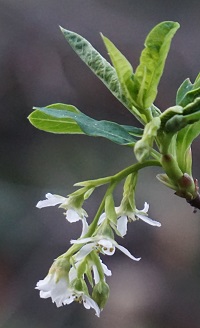 Oemleria cerasiformis (Oso berry)
Oemleria cerasiformis (Oso berry)
Family: Rosaceae
Genus: Oemleria
Common names: Oso berry, Indian plum
This underutilized plant can be cultivated as either a shrub or small tree. It grows up to 12 feet tall and 8 feet wide when mature.
It is deciduous but forms bright green leaves in early spring. It develops flowers at the same time, with cascades of small white flowers appearing as soon as February. Bloom can continue for a couple months and is followed by fruit in late spring and early summer.
One of its common names, Indian plum, comes from its fruit, which resemble small plums when ripe. Its fruit is popular with birds making it a great addition to a habitat garden.
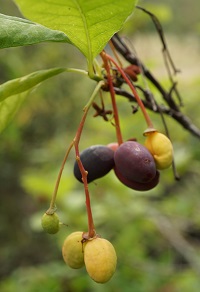
This plant is dioecius, which means that male and female flowers bloom on different plants. You must have at least one of each before the female plants will set fruit. Both male and female plants produce flowers, although the male flowers tend to be a bit showier. Some people think the scent of the male flowers is unpleasant, while the female flowers are said to smell like watermelon.
Oso berry prefers loamy soil, but will tolerate clay. In the wild, it is usually found in moist areas, and it will grow more quickly when provided with water. It is able to handle dry conditions once established. It prefers light shade, but can tolerate full sun.
Native Hill - Update March 2016
Author: Tom Lee
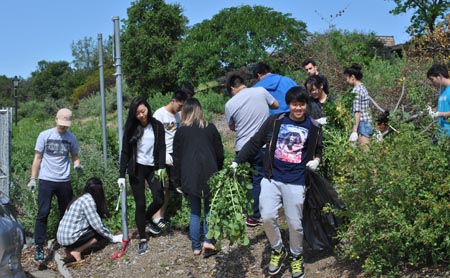
Foothill College is making progress in improving Native Hill. Recently Foothill College completed some Measure C construction work in areas adjacent to Native Hill. For example, the parking lot pathway that divided the Native Hill into two gardens was improved. While this construction was underway, a long awaited irrigation project was put on hold. Now that the Measure C work is completed, most of the Native Hill garden has a new irrigation system installed and the irrigation system will be soon connected to an irrigation controller. In the meantime there are occasional workdays at Native Hill with students from the Horticulture and Biology Departments.
Many of the specimen plants, most of which date back to CNPS, are mature sized. Several species are blooming profusely right now. The newly routed bus passes by a row of Salvias, Aesculus, Arctostaphylos and Cercis that inspire the students with native plants. As with any garden keeping up with the ongoing maintenance tasks is a challenge, and more volunteers can make a big impact in keeping Native Hill in top shape.
The photos above and below were taken by Tom Lee on March 18, 2016, as he joined a workday at Native Hill with a large group of Biology students. The work was pulling out weeds and invasive grasses and then applying mulch.
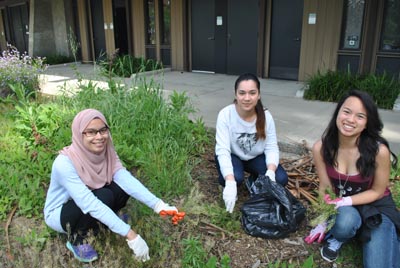
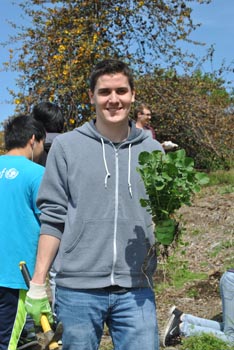
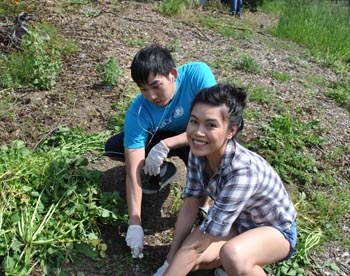
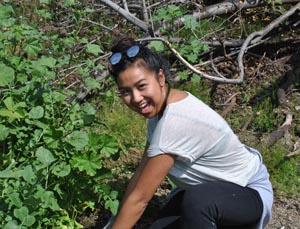
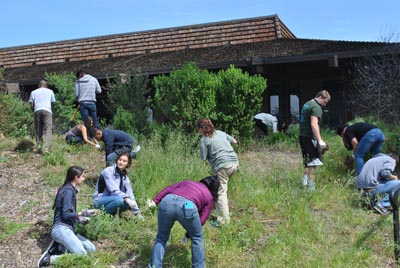
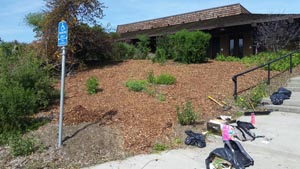
California Native Plants at West Valley College
California native plants dominate the grounds at the West Valley College campus in Saratoga. It’s an excellent place to appreciate a wide variety of mature plants in a garden setting. Starting from the front of the campus, between the Administration building and Campus Center, one immediately encounters a huge bed of California fuschias fuschias (Epilobium canum) interspersed with narrow-leaf milkweed (Asclepias fascicularis), salvia, coffeeberry (Rhamnus californica), California roses (Rosa californica), and blue oaks (Quercus douglasii). When the fuschias begin blooming in late summer, this area becomes a hummingbird haven, filled with a charm of these tiny birds zooming around each defending their own patch of flowers.
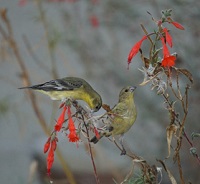 This huge bed of flowers is a wildlife magnet – in addition to hummingbirds, the area is rich with a variety of birds taking advantage of the nectar, seeds and insects. As can be seen in this picture, the flower stalks provide a perfect perch for a pair of lesser goldfinches to enjoy a meal of fuschia seeds.
This huge bed of flowers is a wildlife magnet – in addition to hummingbirds, the area is rich with a variety of birds taking advantage of the nectar, seeds and insects. As can be seen in this picture, the flower stalks provide a perfect perch for a pair of lesser goldfinches to enjoy a meal of fuschia seeds.
Behind the Student Center, there is a patio where Redbud and manzanitas have been planted. A variety of native columbines and other flowers can be found in the flowerbeds that surround the building.
The section of Vasona Creek that runs through the campus has also been restored, and is a delightful place to look for wildlife – including brush rabbits, lizards and more. There have even been reports of bobcats in the area. You c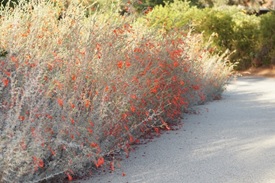 an find out more about this restoration project at: http://westvalley.edu/committees/Sustainability/Creek_Restoration/
an find out more about this restoration project at: http://westvalley.edu/committees/Sustainability/Creek_Restoration/
A stroll through campus will reveal even more California natives. You’ll find specimens of blue elderberry (Sambucus nigra ssp. caerulea), redwood trees (Sequoia sempervirens), deer grass (Muhlenbergia rigens), bush anemone (Carpenteria alifornica), buckeyes (Aesculus californica) and more. There’s even a small bog with carnivorous plants next to the Science building. Be sure to look at the huge blue oak tree in the center of campus – watch it carefully and you are likely to spot the acorn woodpeckers that are often busily at work in it.
The Saratoga Farmer’s Market is held at the campus on Saturday mornings – stop by and get some fresh produce and then take a stroll around campus.
The Life of a CNPS SCV Nursery Plant
When you buy a plant at our nursery, you’re getting the result of a year or more of careful nurturing by our volunteers.
Our plants are grown from both seeds and cuttings, which we obtain from our stock area, commercial growers and CNPS members. We don’t focus on a specific area of the California Floristic Province, so we grow plants for a wide variety of environments from many regions of California – in addition to a wide variety of local natives, we also raise plants from the mountains, deserts and wetlands.
Read more ...
Pollinators and Blooming Beauties [9/16/2015]
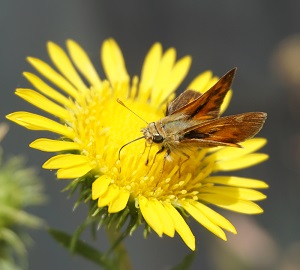
What's Blooming in the Nursery
Most of the time, these articles will be about specific plants that we think you would enjoy adding to your garden. But sometimes, we can't resist sharing the wonders that we see as we work in the nursery. This week the Grindelia camporum (Great Valley gumweed) was a pollinator magnet. Skippers, bees and flies (masquerading as bees) were busily feasting.
Of course, the parade of flowers didn't end there. A few of the others on display included:
- Achillea millefolium (common yarrow) - the Island Pink variety was eye-poppingly bright
- Corethrogyne filaginifolia (common sandaster)
- Dendromecon harfordii (bush poppy)
- Diplacus X (hybrid monkeyflower)
- Epilobium canum (California fuschia)- in addition to the usual reds, 'Summer Snow' brings white into the mix
- Ericameria nauseosa (rubber rabbitbrush)
- Eriogonum (buckwheat) - a huge selection of these wonderful summer and fall bloomers continue to put on a show.
- Monardella macrantha (hummingbird monardella)
- Monardella villosa (coyote mint)
Read more ...
Milkweed (Asclepias) [August 31, 2015]
Milkweed (Asclepias) is the primary host plant for Monarch butterfly caterpillars. Planting locally native milkweed in your garden will provide much needed habitat for these beautiful insects. There are fifteen species of milkweed that are native to California. The Nursery currently grows two of them. More information about California milkweeds is available from the Xerces Society.
Keep in mind that a single plant is usually not enough to provide habitat for butterflies, and providing multiple species of milkweed is better than one. In her book, The California Wildlife Habitat Garden, Nancy Bauer recommends including at least three plants of each species grown.
Asclepias fascicularis (Narrow-leaved Milkweed)
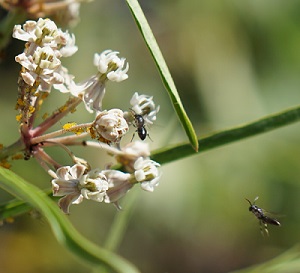 As one might guess from its name, this milkweed has narrow leaves that grow up to five inches long. They are fairly tall plants, growing up to three feet tall with multiple stems topped with clusters of white and pink flowers from June through September.
As one might guess from its name, this milkweed has narrow leaves that grow up to five inches long. They are fairly tall plants, growing up to three feet tall with multiple stems topped with clusters of white and pink flowers from June through September.
This is the most adaptable of the California milkweeds, growing well in both sun and shade, and tolerating both clay and sand. They even do well under oaks and can be found under them in the wild. With their striking flowers and long blooming season, these are ideal plants for any garden.
They are perennials, but will die back to their roots in the fall. They reemerge from their deep taproot in the spring, putting out additional stems each year.
Although they are known for their relationship with the Monarch butterfly, their flowers are also popular with bees and other pollinators.
More information is available at Mother Nature's Backyard and Las Pilitas.
Asclepias speciosa (Showy Milkweed)
This milkweed is native to the Bay Area and northern California. It has wide fuzzy grey to white leaves and spectacular 4 to 5 inch pinkish-white flower heads. It can grow three or four feet tall, although it tends to grow slowly and may take a couple years to reach full height. It prefers full sun and does not need supplemental water once established.
Like narrow-leaved milkweed, it will die down to the roots in the fall. It usually emerges a bit later than narrow-leaved milkweed, so give it time to come up in late spring to early summer. The bloom period doesn't last as long - flowers tend to appear in June and July. However, the huge, gorgeous flowers more than make up for the shorter length of time.
More information about Showy Milkweed can be found on Calflora and Las Pilitas.
Phytophthora in our Nursery?
By Melanie Cross, Chapter Nursery Manager
8/19/2015
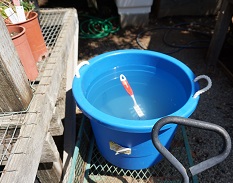 An issue that has surfaced in native plant nursery and revegetation circles this year is the appearance of deadly exotic pathogens: Phytophthora species, and lots of them. You may know of this algae relative because sudden oak death is caused by an airborne species, P. ramorum. The new pathogens that are showing up are water-borne. Susceptible plants at revegetation sites and other landscapes have been devastated by these “plant destroyers.” Unfortunately, nurseries offer the right conditions to cultivate and disseminate them. This is just what we do not want to do.
An issue that has surfaced in native plant nursery and revegetation circles this year is the appearance of deadly exotic pathogens: Phytophthora species, and lots of them. You may know of this algae relative because sudden oak death is caused by an airborne species, P. ramorum. The new pathogens that are showing up are water-borne. Susceptible plants at revegetation sites and other landscapes have been devastated by these “plant destroyers.” Unfortunately, nurseries offer the right conditions to cultivate and disseminate them. This is just what we do not want to do.
Read more ...
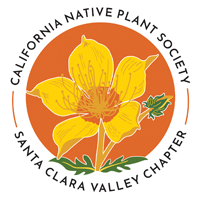

 Oemleria cerasiformis (Oso berry)
Oemleria cerasiformis (Oso berry)







 This huge bed of flowers is a wildlife magnet – in addition to hummingbirds, the area is rich with a variety of birds taking advantage of the nectar, seeds and insects. As can be seen in this picture, the flower stalks provide a perfect perch for a pair of lesser goldfinches to enjoy a meal of fuschia seeds.
This huge bed of flowers is a wildlife magnet – in addition to hummingbirds, the area is rich with a variety of birds taking advantage of the nectar, seeds and insects. As can be seen in this picture, the flower stalks provide a perfect perch for a pair of lesser goldfinches to enjoy a meal of fuschia seeds. an find out more about this restoration project at:
an find out more about this restoration project at: 
 As one might guess from its name, this milkweed has narrow leaves that grow up to five inches long. They are fairly tall plants, growing up to three feet tall with multiple stems topped with clusters of white and pink flowers from June through September.
As one might guess from its name, this milkweed has narrow leaves that grow up to five inches long. They are fairly tall plants, growing up to three feet tall with multiple stems topped with clusters of white and pink flowers from June through September. An issue that has surfaced in native plant nursery and revegetation circles this year is the appearance of deadly exotic pathogens: Phytophthora species, and lots of them. You may know of this algae relative because sudden oak death is caused by an airborne species, P. ramorum. The new pathogens that are showing up are water-borne. Susceptible plants at revegetation sites and other landscapes have been devastated by these “plant destroyers.” Unfortunately, nurseries offer the right conditions to cultivate and disseminate them. This is just what we do not want to do.
An issue that has surfaced in native plant nursery and revegetation circles this year is the appearance of deadly exotic pathogens: Phytophthora species, and lots of them. You may know of this algae relative because sudden oak death is caused by an airborne species, P. ramorum. The new pathogens that are showing up are water-borne. Susceptible plants at revegetation sites and other landscapes have been devastated by these “plant destroyers.” Unfortunately, nurseries offer the right conditions to cultivate and disseminate them. This is just what we do not want to do.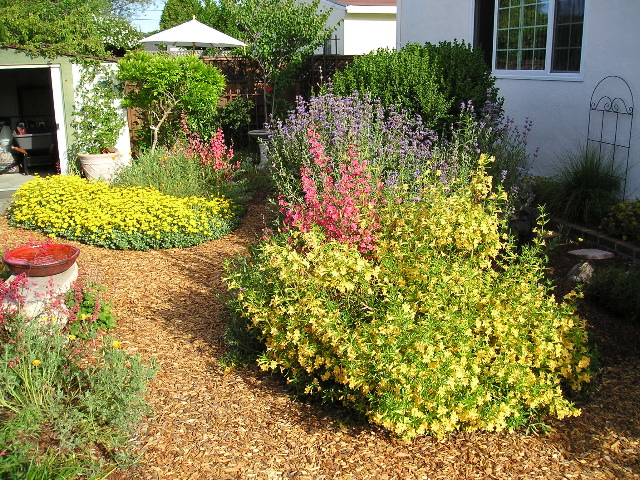 Do you want a garden teeming with life? One that changes with the seasons? One that looks stunning? One that saves water, energy, effort, and money? Consider incorporating California native plants in your garden to attract butterflies, birds, and other wildlife. These beautiful plants will bring seasonal color to your landscape. They will give your California garden a unique sense of place.
Do you want a garden teeming with life? One that changes with the seasons? One that looks stunning? One that saves water, energy, effort, and money? Consider incorporating California native plants in your garden to attract butterflies, birds, and other wildlife. These beautiful plants will bring seasonal color to your landscape. They will give your California garden a unique sense of place.